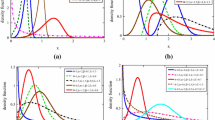Abstract
A perpetuity is a random variable that can be represented as \(1 + W_1 + W_1 W_2 + W_1 W_2 W_3 + \cdot \cdot \cdot ,\), where the W i's are i.i.d. random variables. We study exact random variate generation for perpetuities and discuss the expected complexity. For the Vervaat family, in which\(W_1 \underline{\underline {\mathcal{L}}} {\text{ }}U^{1/\beta } ,\beta > 0,U\) uniform [0, 1], all the details of a novel rejection method are worked out. There exists an implementation of our algorithm that only uses uniform random numbers, additions, multiplications and comparisons.
Similar content being viewed by others
References
M. Abramowitz and I. A. Stegun, Handbook of Mathematical Tables, Dover Publications: New York, N.Y., 1970.
L. Bondesson, “On simulation from infinitely divisible distributions,” Advances in Applied Probability vol. 14 pp. 855-869, 1982.
N. Bouleau, Processus Stochastiques et Applications, Hermann: Paris, 1988.
J. F. Chamayon, “Pseudo random numbers for the Landau and Vavilov distributions,” Journal of Computational Physics, 1997.
J. F. Chamayon and B. Schorr, “On a class of random variables arising in atomic cascade models,” Report, European Organization for Nuclear Research, Geneva, 1975.
P. Danien, P. W. Laud, and A. F. M. Smith, “Approximate random variate generation from infinitely divisible distributions with applications to Bayesian inference,” Journal of the Royal Statistical Society vol. B57 pp. 547-563, 1995.
P. J. Davis and P. Rabinowitz, Methods of Numerical Integration, Academic Press: New York, 1975.
L. Devroye, “The computer generation of random variables with a given characteristic function,” Computers and Mathematics with Applications vol. 7 pp. 547-552, 1981a.
L. Devroye, “The series method in random variate generation and its application to the Kolmogorov-Smirnov distribution,” American Journal of Mathematical and Management Sciences vol. 1 pp. 359-379, 1981b.
L. Devroye, “On the use of probability inequalities in random variate generation,” Journal of Statistical Computation and Simulation vol. 20 pp. 91-100, 1984a.
L. Devroye, “Methods for generating random variates with Pólya characteristic functions,” Statistics and Probability Letters vol. 2 pp. 257-261, 1984b.
L. Devroye, “An automatic method for generating random variables with a given characteristic function,” SIAM Journal of Applied Mathematics vol. 46 pp. 698-719, 1986a.
L. Devroye, Non-Uniform Random Variate Generation, Springer-Verlag: New York, 1986b.
L. Devroye, “On random variate generation when only moments or Fourier coefficients are known,” Mathematics and Computers in Simulation vol. 31 pp. 71-89, 1989.
L. Devroye, “Algorithms for generating discrete random variables with a given generating function or a given moment sequence,” SIAM Journal on Scientific and Statistical Computing vol. 12 pp. 107-126, 1991.
N. G. de Bruijn, “The asymptotic behaviour of a function occurring in the theory of primes,” Journal of the Indian Mathematical Society vol. 15 pp. 25-32, 1951.
D. Dufresne, “The distribution of a perpetuity, with applications to risk theory and pension funding,” Scandinavian Actuarial Journal pp. 39-79, 1990.
D. Dufresne, “On the stochastic equation L.X. L.B.X. C. and a property of gamma distributions,” Bernoulli vol. 2 pp. 287-291, 1996.
D. Dufresne, “Algebraic properties of beta and gamma distributions, and applications,” Advances in Applied Mathematics vol. 20 pp. 285-299, 1998.
P. Embrechts and C. M. Goldie, “Perpetuities and random equations,” in: P. Mandl and M. Hušková (eds) Asymptotic Statistics: Proceedings of the Fifth Prague Symposium, Physica-Verlag: Heidelberg, pp. 75-86, 1994.
P. Embrechts, C. Klüppelberg, and T. Mikosch, Modelling Extremal Events, Springer-Verlag: Berlin, 1997.
C. M. Goldie and R. Grübel, “Perpetuities with thin tails,” Advances in Applied Probability vol. 28 pp. 463-480, 1996.
R. Grübel and U. Rösler, “Asymptotic distribution theory for Hoare's selection algorithm,” Advances of Applied Probability vol. 28 pp. 252-269, 1996.
H. Kesten, “Random difference equations and renewal theory for products of random matrices,” Acta Mathematica, vol. 131 pp. 207-248, 1973.
J. G. Propp and D. B. Wilson, “Exact sampling with coupled Markov chains and applications to statistical mechanics,” Random Structures and Algorithms vol. 9 pp. 223-252, 1996.
J. Spanier and K. B. Oldham, An Atlas of Functions, Springer-Verlag: Berlin, 1987.
L. Takács, “On secondary processes generated by a Poisson process and their applications in physics,” Acta Mathematica Academiae Scientificarum Hungarica vol. 5 pp. 203-236, 1954
L. Takács, “On stochastic processes connected with certain physical recording apparatuses,” Acta Mathematica Academiae Scientificarum Hungarica vol. 6 pp. 363-379, 1955.
G. Ulrich. “Computer generation of distributions on the m-sphere,” Applied Statistics vol. 33 pp. 158-163, 1984.
W. Vervaat, “On a stochastic difference equation and a representation of non-negative infinitely divisible random variables,” Advances in Applied Probability vol. 11 pp. 750-783, 1979.
S. G. Walker, “Random variate generation from an infinitely divisible distribution via Gibbs sampling,” Technical Report, Imperial College, London, 1996.
Author information
Authors and Affiliations
Rights and permissions
About this article
Cite this article
Devroye, L. Simulating Perpetuities. Methodology and Computing in Applied Probability 3, 97–115 (2001). https://doi.org/10.1023/A:1011470225335
Issue Date:
DOI: https://doi.org/10.1023/A:1011470225335




